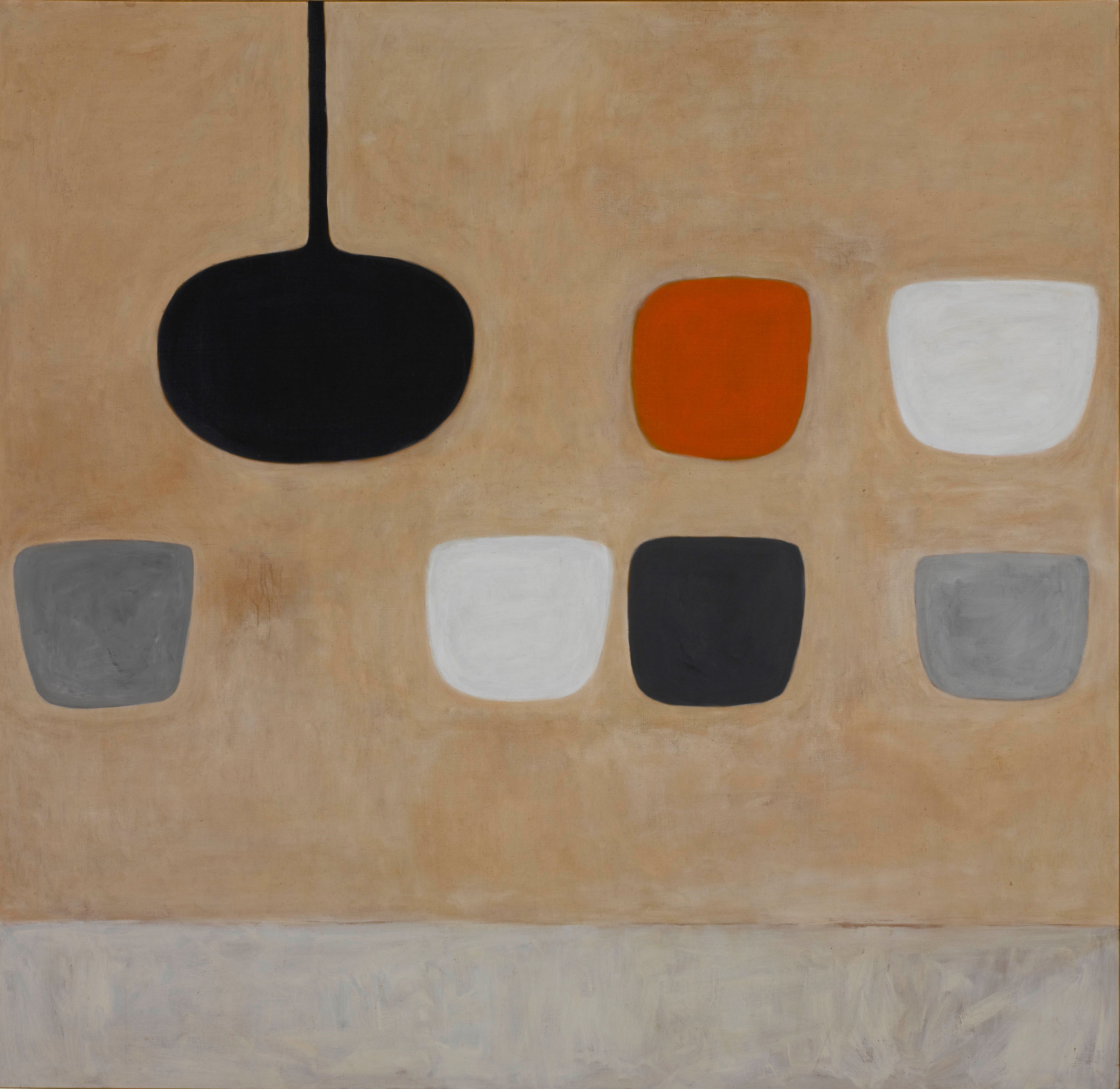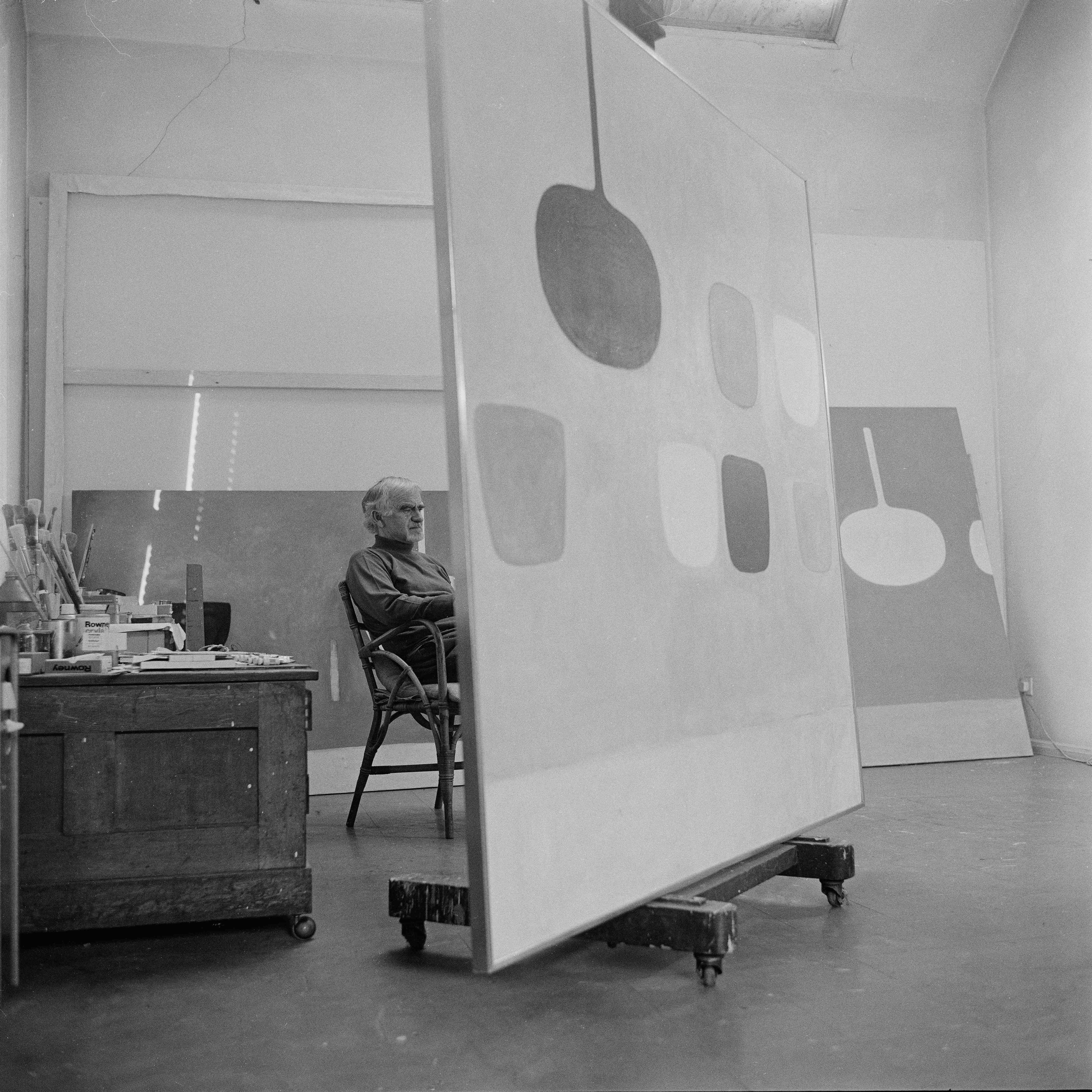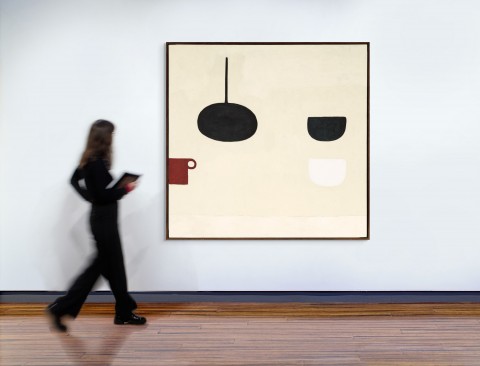NEW STILL LIFE STUDY, 1983
WILLIAM SCOTT
oil on canvas
167.5 x 172.5 cm
signed and dated verso: W SCOTT 83
original Robert Sielle frame
Gimpel Fils Gallery, London (label attached verso)
Gimpel & Weitzenhoffer Gallery, New York
Private collection, New York, acquired from the above in June 1983
Sotheby’s, London, 4 November 1992, lot 120 (as ‘Untitled’)
Bernard Jacobson Gallery, London
Annandale Galleries, Sydney (label attached verso, as 'New Life Study')
Private collection, Sydney, acquired from the above in 1999
William Scott, Gimpel and Weitzenhoffer, New York, USA, 26 April – 28 May 1983
William Scott: A Retrospective, Bernard Jacobson Gallery, London, UK, 3 April – 11 May 1997
William Scott: paintings and works on paper, Annandale Galleries, Sydney, in association with Bernard Jacobson Gallery London, 11 May - 12 June 1999, cat. 5
Whitfield, S. (ed.), William Scott: Catalogue Raisonné of Oil Paintings, Thames & Hudson, London, in association with the William Scott Foundation, 2013, cat. A166, vol. 4, p. 378
William Scott Still Life With Orange Note, 1970

|
William Scott
Still Life With Orange Note, 1970
oil on canvas, 168.0 x 172.0 cm
National Museums Northern Ireland, Belfast
© Estate of William Scott
|
Despite being one of the most influential modern British painters of the 20th century, William Scott remains an enigmatic figure in recent art history. He is, as is too often said, ‘a painters’ painter’. Praised and admired by other artists for his lifelong dedication to his craft, for his handling of paint, and for his extraordinary capacity to breathe life into a relatively limited range of subject matter, Scott’s work is rightly celebrated for its pictorial eloquence and for the way in which it elegantly hovers between representation and abstraction. As the artist remarked in 1955: ‘I seem to paint the same subject, whether it is still life, figure or landscape. There is no escaping. One can develop it, but never change it.’1
Born of humble origins in Greenock, Scotland, William Scott grew up in his father’s hometown of Enniskillen, in Northern Ireland. Scott took local art classes from the age of eleven, leaving school at fifteen after the tragic death of his father to study at Belfast College of Art before gaining a place in the sculpture school of the Royal Academy of Art in London in 1931 (Scott transferred to painting in 1934). After his marriage to fellow artist Mary Lucas in 1937, the couple lived for a period in Italy, and then, Pont-Aven in Brittany, France; finally settling, in 1941, in Hallatrow in Somerset. Scott joined the army in 1942, serving initially with the Royal Army Ordinance Corps before working as a lithographic draughtsman for the Royal Engineers. Although not demobilised until January 1946, he was fortunate to be able to both paint and exhibit during this time. On the other side of the war, Scott found himself an artist on the rise. He was appointed Senior Painting Master at the Bath Academy of Art at Corsham Court in Wiltshire, England in 1946 (where, amongst his students was Howard Hodgkin) and was to represent Britain, along with Kenneth Armitage and William Hayter, at the Venice Biennale in 1958.
The years after WWII heralded a period of experimentation for Scott, who, like many artists at the time, struggled to grasp the relevance and contribution of art after such global devastation, and with finding a way, personally, to move it forward.2 During a trip to New York in 1953, Scott became one of the first British artists to meet and experience the work of American Abstract Expressionists such as Jackson Pollock, Willem De Kooning, Franz Kline and Mark Rothko, who was to become a long-term correspondent and friend. However, despite being impressed by the scale, ambition and confidence of their work, this encounter only served to reinforce the roots of Scott’s own practice in the European tradition.3 As he reflected: ‘There’s a whole tradition from Chardin to Cézanne and Braque and Bonnard which has no part in American painting, and that is the tradition I’ve always held to.’4
By the time Scott made New Still Life Study in 1983, he had been painting his still life compositions of kitchen paraphernalia—pots, pans, bottles, jugs, bowls and knives—for close to four decades, finding endless inspiration in the formal qualities of these mundane everyday items and in their capacity to hold both space and form. As he wrote in 1953:
William Scott, 1972

|
William Scott, 1972
photographer: Jorge Lewinski
© The Lewinski Archive at Chatsworth
All Rights Reserved 2024/Bridgeman Images
|
‘About four years ago I painted a picture of a frying pan and a whole napkin. I had been interested in the work of Braque for a long time, but I felt that it was dishonest to merely take as some people have done the guitar, the carafe and the French loaf. I felt that in painting my own familiar objects I might imbue them with a conviction characteristic of both myself and my race, if the guitar was to Braque his Madonna, the frying pan could be my guitar, black was a colour I was fond of and I possessed at that moment a very black pan.’5
By the 1980s however, the occasional foodstuffs – eggs, fish and lemons, for example, and tilted tabletops of his earlier work had disappeared, replaced by his now signature kitchen objects abstracted and floating in space. Reduced to the sparest of means in New Still Life Study, the frying pan, with its handle pointing straight up, is viewed from above, while the bowls and cups are seen in profile. The artist’s formerly rich handling of paint is similarly reduced to the sparest of means – thin veils of monochromatic colour that seem to amplify the sense of stillness and suspension contained within the square of the composition. Interestingly, for Scott, framing was also an essential part of realising (and controlling) his vision. The simple, dark wooden frame of New Still Life Study, made by Scott’s long-term framer Robert Sielle,6 at once contains and amplifies the emblematic forms within it, encouraging a sense of stillness and contemplation. Created by an artist at the height of his powers, within this beautiful work, nothing is left to chance.
Due to the dedication and hard work of the William Scott Foundation, established by the artist’s two sons, James and Robert Scott in 2007, Scott’s reputation and contribution has continued to thrive after his death. William Scott CBE RA is currently represented in The Shape of Things: Still Life in Britain at Pallant House Gallery, Chichester, UK (11 May – 20 October 2024) and will be part of the forthcoming exhibition St Ives, and Elsewhere. Post-War British Painting at the Museum Sztuki in Łódź, Poland in 2025.
1. Russell, J., ‘Prologue’ in Lynton, N., William Scott, Thames & Hudson, London, 2004, p. 8
2. ‘William Scott and Abstraction,' TateShots, Tate, 2013, see: https://www.youtube.com/watch?v=CfhHZSpFzYQ (accessed 28 June 2024)
3. Lynton, op. cit., p. 465
4. ibid. p. 7
5. ‘Archive Blog – November 2016. William Scott: a painter of pots and pans…’, William Scott Foundation, see: http://williamscott.org/2016/11/07/archive-blog-november-2016/ (accessed 28 June 2024)
6. Whitfield, S. (ed.), William Scott: Catalogue Raisonée of Oil Paintings 1969 – 1989 Catalogue Numbers 657 – 935, Volume 4, Thames & Hudson in association with William Scott Foundation, London, 2013, pp. 11, 378
KELLY GELLATLY

